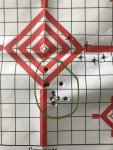So I was shooting an AR10 in 308 yesterday (prone, bipod and rear bag) and I'm just trying to figure out what load it likes (eventually try to replicate that load with handloads).
I shot some cheap stuff and got cheap accuracy (2-3 MOA) so I pulled out some 175gr FGMM. My group was about 2 MOA but the first shot was the one that opened the group up. The last 4 were all more like 0.75 MOA. Happy with that but I have no idea why that first shot was significantly higher than the rest (barrel was already warm). So I load up 5 more, hold same POA and proceed to put 4/5 into a 1 MOA group (including 4 from the first group).
At the end of the day, I ended up with a 2.5 MOA 10-shot group. But if I exclude the 1 flyer, I had an 9-shot group closer to 1-1.4 MOA with 5 of them stacked into 0.45 MOA. Very happy with that.
My question is, those of you who use 10 shot groups, do you also use a hit %? I never paid much attention to hit % until this experience. Basically, 100% of the time I will hit a 2.5 MOA target, but 80% of the time I would hit a 1 MOA target and 50% of the time I would hit a 0.5 MOA target. What's the best way to determine what the capability of your system is?
I guess just as an observation, a "lucky" 5-shot group would have lead me to believe I had a 0.5 MOA gun and stopped shooting. I'm sure I could grab the other 10 rounds of the FGMM and they would probably all end up in a 1.75 MOA group.
I shot some cheap stuff and got cheap accuracy (2-3 MOA) so I pulled out some 175gr FGMM. My group was about 2 MOA but the first shot was the one that opened the group up. The last 4 were all more like 0.75 MOA. Happy with that but I have no idea why that first shot was significantly higher than the rest (barrel was already warm). So I load up 5 more, hold same POA and proceed to put 4/5 into a 1 MOA group (including 4 from the first group).
At the end of the day, I ended up with a 2.5 MOA 10-shot group. But if I exclude the 1 flyer, I had an 9-shot group closer to 1-1.4 MOA with 5 of them stacked into 0.45 MOA. Very happy with that.
My question is, those of you who use 10 shot groups, do you also use a hit %? I never paid much attention to hit % until this experience. Basically, 100% of the time I will hit a 2.5 MOA target, but 80% of the time I would hit a 1 MOA target and 50% of the time I would hit a 0.5 MOA target. What's the best way to determine what the capability of your system is?
I guess just as an observation, a "lucky" 5-shot group would have lead me to believe I had a 0.5 MOA gun and stopped shooting. I'm sure I could grab the other 10 rounds of the FGMM and they would probably all end up in a 1.75 MOA group.


